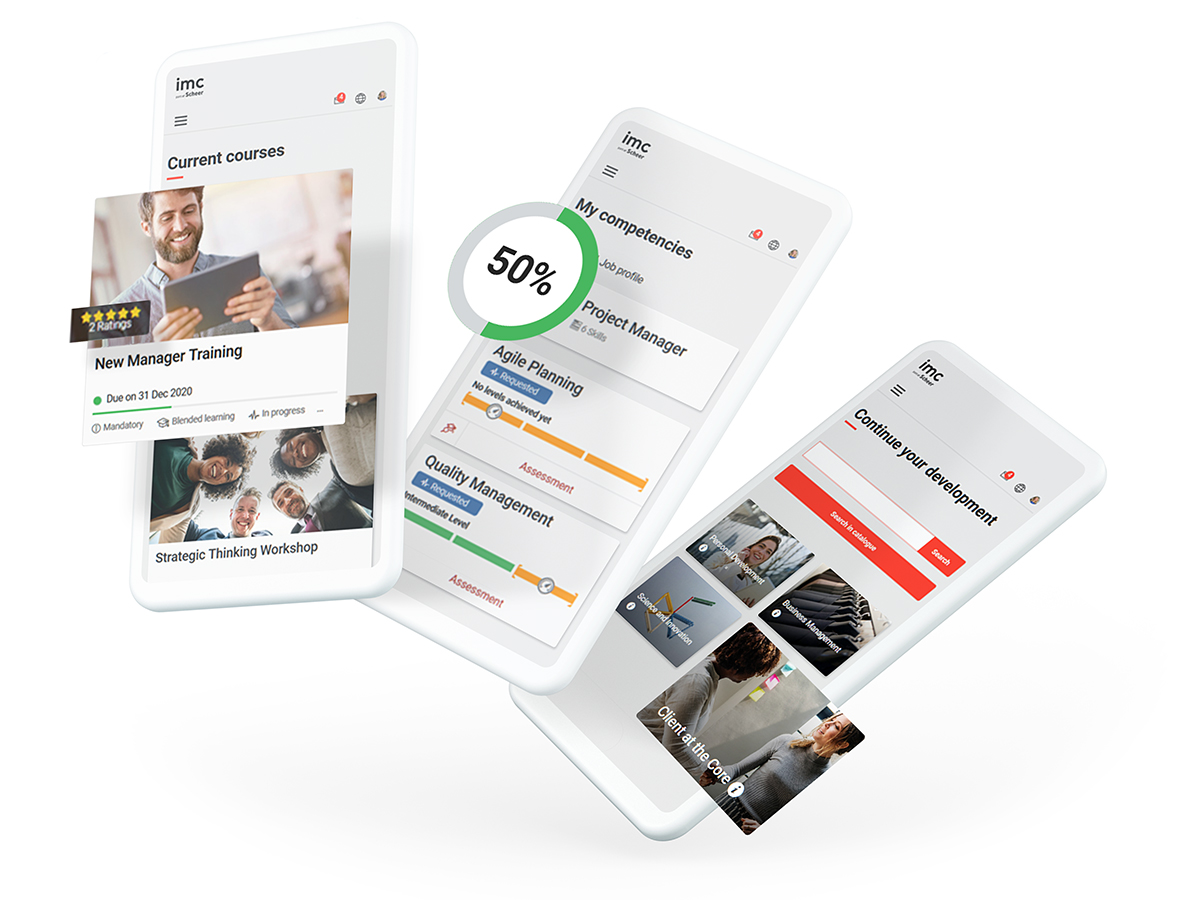
Cohort-based Learning: Learning Together Beats going it Alone
What cohort-based learning is all about, and why learning online and learning together are not mutually exclusive.
Doing e-learning from the comfort of your home PC has many benefits. But it’s very much a solitary experience: no interaction, and no peers to keep you motivated and spur you on.
But thanks to cohort-based learning, it doesn’t have to be that way. With cohort-based learning, you can combine the benefits of group dynamics with PC-based self-learning.

Definition: What is cohort-based learning?
“Cohort-based learning” is a complicated-sounding name for something that more or less means learning as a group.
DEFINITION
Cohort-based learning creates an environment that enables active, collaborative and learner-centric learning.
It is a model of education that puts learners into groups so that they learn together, share ideas and support each other. Unlike one-on-one tuition and self-study, cohort-based learning is inherently collaborative and interactive.
As the name suggests, it is done in cohorts: groups of learners who typically have similar interests, objectives or backgrounds. The cohort members progress together through a structured curriculum or course that can include both online and in-person elements. The learners have regular opportunities to meet up, either in person or by means of virtual communication platforms. This motivates them to deepen their knowledge and discuss topics in more detail. It also enables them to work on joint projects.

Group dynamics at its best: Demonstrably higher success rates
A key advantage of cohort-based learning is that learners benefit from the different perspectives, experiences and skills of their peers. The regular interaction fosters a strong sense of community and cohesion, which can be very motivating and supportive. What’s more, the cohort members can learn from and help each other and grow through ongoing feedback.
Cohort-based learning is more than just a nice-to-have for injecting a bit of variety into the learning process. It actually delivers significantly higher success and completion rates than achievable through solo learning.
Cohort-based learning in action in enterprise practice
Cohort-based learning can be used in all areas of education. And it’s not a new concept per se. It’s as old as school classrooms, where everyone learns together and in person.
What’s new is that it can also be used in corporate settings – and it’s not limited to in-person learning. As part of a blended-learning strategy, cohort-based learning can comprise both online and in-person models.
So, how might that look in practice? imc instructional designer Benjamin Fillisch explains using a few concrete customer examples:
“At Vodafone, we developed a digital yet highly effective and motivating onboarding programme. The solution needed to cater to three distinct user groups: in-house and external customer service representatives and retail store staff. So, we developed a blended-learning journey that included cohort-based learning.”

The spirit of learning at Jägermeister: Don’t bother showing up if you haven’t done your homework!
Even the drinks industry needs learning. In this case, employees at Jägermeister needed to learn how to implement the brand’s new e-commerce strategy. The learners spanned four distinct, globally distributed groups, including sales staff and C-Level executives.
They were put into country and learning-specific cohorts. Collaborating via Miro , they had to define which stakeholders needed to be on board in order for the strategy to be rolled out successfully.
After the first virtual classroom, each cohort was given an assignment and told exactly what to prepare for next time. They were told they needn’t join the next session if they hadn’t done their homework. Why should everyone be forced to repeat a session just because someone hasn’t prepared?

In essence, the message to the participants was this: Your time and ours is valuable, so it’s only worth meeting if we are prepared. Otherwise, we can’t hope to produce outcomes that are any use to anyone.
That may sound harsh, but it was very well received. The participants, especially the C-level personnel, valued the clear expectations and certain knowledge that their time would be used productively. Firm deadlines and mutual accountability gave the participants certainty that their learning sessions would have a meaningful outcome. The result: increased acceptance of the learning by all concerned. This is one of the key benefits of cohort-based learning.
Quick guide to cohort-based learning
Here are some of the key points for getting the most out of cohort-based learning:
- Careful analysis of requirements and target group
- Good mix of in-person and digital learning
- Clear communication about rules, expectations and outcomes
- Generate added interest through gamification
- Present time-sensitive information in virtual classrooms
Above all, don’t forget the fun factor! Whatever the learning, we’re more likely to retain it if it’s entertaining and fun. And that’s true whether we’re learning alone or in cohorts.

Can Germany afford its current AI scepticism?
Artificial intelligence (AI) is often viewed sceptically in Germany, but often without justification. In this interview with Kristian Schalter, we talk about how future technologies will change our working world.

AI in Corporate Learning
There are many fears about the topic of artificial intelligence (AI). But especially in corporate learning, AI can be a great help.

Contact person
I joined the imc newsroom team in 2021. As a journalist my heart beats for content and storytelling.
I’m excited to figure out how e-learing and digitization affect the future of work. My task is to create content to talk about and I’m always looking for trends.
Privately I love to travel and eat Tapas.
Topics: E-Learning Trends, Corporate Social Responsibility, Press and Influencer Relations

Diary of a Learning Management System
imc Learning Suite: Six pro tips to make your life easier when working with the LMS
Ever had words with your car? Yelled at the TV? Sworn out loud as you stab angrily at your PC keyboard? Or muttered “stupid system!” – only to discover, somewhat sheepishly, that the problem lay with you, not the system? It’s OK, we’re no different. Our consultants are intimately familiar with this phenomenon, too.
That’s why we talked to our consultants about the misconceptions and obstacles that most frequently cause LMS clients grief, and how they can be overcome. And sometimes it’s good to see things through the other person’s eyes, so we’ve decided to write this from the point of view of our learning management system and share some tips for a better handling of the LMS. That’s right, you may not be aware of it, but our LMS has feelings too, and it’s only trying to help!
The following excerpt from the diary of our learning plattforn is a light-hearted take on human-system interaction, but it contains genuine and practicable expert advice that will hopefully make working life less stressful and more relaxed for all concerned – you, the system, and our consultants.

Dear Diary,
8 a.m.: Dealing with a sudden mass influx of visitors
This morning, I wasn’t even fully awake and was hoping for a slow start to my day, but then I received another error message from China. It was from that important guest who checked in recently. Humans, by the way, always call guests “clients”, but “guests” sounds so much nicer to me.
Anyway, this super-important guest thinks it’s okay to check in an additional 50,000 learners without first telling us and giving my human colleagues – imc’s consultants and architecture experts – a chance to make the necessary server preparations. These preparations are quick to implement, but they’re not instantaneous. I mean, have you ever tried to find room for 50,000 guests who show up on your doorstep unannounced? We pride ourselves on being great hosts, and part of being a great host is being prepared.
Pro tip 1:
If you know you are going to need a large volume of additional licences, please give the consultants in charge seven to ten days’ advance notice.
Note: This does not apply to completely new clients or enterprise groups. In these cases, the preparations take an average of three months, as the process is a lot more involved.
12:15 p.m.: Bugs vs. user errors: Banishing misconceptions
My personal coach, Lia, always says I need to work on my stress management – it was her recommendation to keep a diary. I like Lia. She listens and helps me manage my endearing little peculiarities – the things that humans for some reason call bugs.
Bugs! Such an unkind word to use, given that everyone has their little quirks and tics. And to be perfectly honest, many of so-called bugs are not actually my fault, they’re user errors. There is always potential for user error, which is why my human colleagues and experts – wonderful people like Andreas and Christian – are there to help. They are excellent human-machine interpreters and are only too happy to clear up these sorts of little misunderstandings and misconceptions.
Pro tip2, for system administrators
Please do the user training sessions with our consultants and refer to the relevant training documentation. It will save a lot of time, boost productivity and reduce stress. That’s a promise!
1:00 p.m.: How gamification boosts motivation and enhances learning outcomes
It’s so pleasing to see that my new functions are being accepted and used by more and more guests. And to think that only a couple of years ago, they still had to log in separately to every system I’m connected to. Such a chore and a bore! But now, thanks to single sign-on authentication, it’s all so much simpler, and they can now access the entire learning ecosystem with a single click.
A lot has happened on the gamification front too. Being able to collect badges after completing courses is extremely motivating and makes learning much more fun. Up until quite recently, gamification tended to be frowned upon, especially in the more staid German companies. They’re supposed to be learning, not playing! Well, I disagree, because I can combine learning and play.
Successful learning comes from motivation, which is why I wholeheartedly recommend my skill management feature. With skill management, I can facilitate employee development by highlighting the skills employees already possess, and those they are yet to acquire.
The employer can then compare this information with the skill requirements in job profiles to identify which candidates still need development in specific areas, and which ones are suitable for the role because they already have the required skill set. This can be applied to all selection scenarios, from promotions to filling vacancies. I firmly believe that not using this feature is a wasted opportunity, particularly for guests who have a lot of office-based employees.
Pro tip 3
Don’t be afraid to move with the times! E-learning is so yesterday. Today, it’s all about creating unique learning experiences. Whether it’s small hacks, the use of gamification, or skill management, your employees will not only love it, they will become more productive.

3:30 p.m.: Using Netflix-like features to create unique learning experiences
Time for a coffee break, time to share a little secret: I will soon be getting some amazing new functions. And the best thing about it is that people are comparing me with Netflix – finally, a function that’s instantly recognizable for every user! Very clever of my developers to have come up with this: my new ability to recognize when different items of learning content deal with related topics. I can now recommend new courses or learning videos based on these similarities.
I can’t wait to see how this function is received once the first guests start trying it out. Who ever said learning systems are unsexy?
Pro tip 4
You should definitely check out the new channel function. Channels not only look great, they transform learning into a real experience.
3:45 p.m.: Courses and learning paths made easy
That’s my caffeine fix sorted. Time to move on to the next real challenge – in the form of a new guest from Australia. This guest creates three new courses, then complains that there’s no easy overview of who has done the courses or completed the tests.
But that’s another major misconception, unfortunately, because the solution he needs is already there: learning paths. Let me explain. First of all, there’s learning content. That can be any kind of training, whether face-to-face or digital. If I combine multiple items of content, then that’s a course. I can then combine multiple courses to create a learning path. If I want to, I can then also define various course prerequisites.
The idea of prerequisites is that the learner can’t progress to a higher-level course until they have passed the courses below it. You can even create placeholders – course templates – for individual courses in the learning path if, say, the course dates have not yet been finalized. Guests can then book the relevant courses in the learning path once the dates have been finalized, and the courses created. With this set-up, the administrator will always have total transparency regarding how far along the learning path the individual learners are, and can see full details of the courses.

Pro tip 5
Learning paths need to be well thought out because they are intended for longer-term development programmes. In that sense, they are like semester schedules at universities. The latter comprise various lectures or courses, and by the end of the semester, students need to have attended all the lectures in order to pass.
So, it’s important to think carefully in advance about the purpose for which an item of learning content, a course or learning path is being created. Once you have created a learning path, it’s not that easy to make changes. If you are unsure, it’s best to double check with our consultants.
5:00 p.m.: Smart decisions with learning analytics
What a day! But the end is in sight. Meanwhile, there’s something I really want to get off my chest: I’m a precision system, and I can show humans exactly what they want to – or are allowed to – see, but only if they correctly specify what they want via my user interface.
The same principle also applies to authorisations. It makes total sense that sales consultants who only sell, say, drilling machines should not need access to user guides for gardening tools. But to give effect to that, you actually need to specify it in the roles and rights concept. That way, the group defined as “sales consultants for drilling machines” will only be able to view user manuals for drilling machines.
Also, my creators are constantly talking about learning analytics and how it can be used to create really cool dashboards. That’s another new functionality that I’m very proud of. Learning analytics enables you to “measure the business outcome of the learning process,” as my big boss and Head of Product Management here at imc, Wolfram Jost, would say. In other words, learning analytics lets humans track whether they are getting a good return on their investment in learning. Definitely a key technology to keep an eye on!
Pro tip 6
To get the right answers, you have to ask the right questions, so, if you would like to make purposeful use of learning analytics, it’s worth talking to a data expert or asking our consultants about targeted training courses.
6:00 p.m.: Performance review and new developments on the horizon
Well, it’s nearly time to finish up for the day, and I’ve got a really nice evening planned. The product management team will be coming by shortly, and I’ll be paying really close attention to what they say, because it’s about my future. I love my product managers because they’re always checking me over closely to spot untapped potential and find ways of making me even better than my competitors. Time to grab some data snacks, sit back and relax. I can’t wait to find out what updates they’ve got in mind for me.
Ok, Diary, talk to you again tomorrow!

Learning Ecosytem: A universe of Learning
If you want to use a learning ecosystem successfully in corporate learning, the technical requirements must be right. Time to shed light on what systems have to fulfil in order to be able to meaningfully map a genuine learning ecosystem.

The Ultimate eLearning Jargon Glossary
LMS, LXP, SCORM, WBT, EPSS, NGLE, CBT, ITS!? Lost in a world of elearning terms and abbreviations? No worries, we can help. In this A to Z, we shed some light on the subject and have compiled a list of the most important terms and abbreviations in the field of e-learning in 2022.

More about our LMS
If you would like to learn more about imc's Learning Management, check here for more information.

Contact person
I have been working in the Marketing & Communication Team at imc since March 2019.
Communication, creative content and social media are my passion. "KISS - Keep it short and simple" is my credo.
To explain complex content in an understandable way and thus make the topic of e-Learning accessible to everyone is an exciting challenge every day.
Privately I love to read, play poker and travel a lot.
I am always happy to receive feedback or suggestions.

Learning Management Systems for Membership Organisations - Key Features to Look For
Here we look at the unique requirements you should look for in a learning management system (LMS) for membership organisations, in order to make your platform effective for current and future training needs, while improving many other aspects of member administration.
Over the last few years, many professional bodies and trade associations have added online training, services and member benefits via an LMS to supplement their offline offerings.
However, as everyone is becoming more tech savvy and comfortable in doing more of their business and social networking online, many membership organisations now conduct the majority of their communication via an LMS or online portal, with some even being primarily or entirely run online.
Add to this the need for social distancing and remote communication while the coronavirus pandemic continues through 2021, and many membership organisations need an online hub to be able to function at all.
Often, generic LMS solutions can technically be adapted to meet the needs of a membership organisation with some custom development work. However, choosing one that has this use case catered for by design (rather than being very focused on training internal company employees) can save a lot of hacking around and headaches.
At imc, our Learning Suite has been developed with membership organisations as a key user-type, making it easy for administrators to organise training, certifications, CPD / CE, online communication and much more.

LMS key features for a membership organisation
These are some of the key features we have worked to continually improve, and that we recommend you look for when choosing the best LMS for a membership organisation like yours:
CPD / CE
Many professional membership organisations require a level of Continuing Professional Development (CPD) / Continuing Education (CE) for members to demonstrate their commitment to staying up to date with the latest industry information and best practices.
Therefore, a good membership LMS will help both users to follow and record any points-based training, whether conducted online or offline, while enabling administrators to signpost suitable courses and content.
Social Learning
While the typical LMS for employee learning and development will be set up to deliver on the top-down training requirements in line with a company’s business and compliance needs, many people join an organisation for the benefits of expert instructor and peer to peer support.
Therefore, a membership LMS should facilitate group chats, threaded discussions, and many of the content liking, sharing and commenting features that users will be familiar with from social media platforms like Facebook, Twitter and LinkedIn.
Multi-Tenancy
Membership bodies, especially larger organisations, may have multiple types of learners, each with their own needs in terms of features, as well as content. For example, there will be the members themselves - who may form one or more type - there may be the organisation’s own staff who need training and their own ongoing support and development, and there may be external partners, such as affiliates and 3rd party training companies.
A multi-tenancy LMS like imc Learning Suite allows you to use a single learning platform instance to create distinct learning environments for each of your audiences. Each group sees only their self-contained learning experience, which can be tailored to their needs in terms of content, hierarchies, active features, and even branding.
Learn more about multi-tenancy here.

Low-Cost Scalability
Many trade associations and membership organisations, including some of our clients, have tens or even hundreds of thousands of members. Therefore, you’ll want to make sure your LMS can scale with you to large numbers of members without costs spiralling out of control.
Unlike online training for company employees, many organisation members will need to stay enrolled but may be relatively passive - perhaps not active at all for many months or longer.
Therefore, the pricing model used within an LMS for membership organisations should be tailored to or flex to reflect that lower level of resource usage seen within a typical corporate LMS that will be priced based on users / active users.
Software Integrations
Of course, there are many moving parts within a membership organisation, with training being just one of them. Admin time is therefore a potentially big expense, so management of member data should be as seamless as possible across software platforms for CRM, email, video conferencing, finance, multimedia content and more using APIs.
For example, imc offers easy integration with popular 3rd party applications such as PayPal, Shopify, GoToMeeting, Microsoft Teams, Linkedin Learning and Salesforce.
It’s this streamlining of software products that enabled the RIBA (Royal Institute of British Architects), who have 47,000 members worldwide, to go from 5 different systems for attendance bookings, training content, email notifications and more to managing everything within their LMS.
Adaptive Learning
Keeping content relevant and fresh is key for learner engagement with your content. Adaptive learning capabilities within your LMS helps to intelligently assess learners’ existing competencies as they progress through training content. It will guide them to what they need to learn and improve on, and reduce the repetition and frustration that can come from ploughing through training where they are already capable.
eCommerce
LMS ecommerce functionality enables a membership organisation to deliver self-service enrolment, and purchase of individual or group courses, event attendance and more.
For larger organisations especially, this can greatly reduce admin overhead and bring significant cost savings. Look for integrations with popular ecommerce payment gateways, such as PayPal and Shopify.

Virtual Conferences
Prior to the Covid-19 pandemic, many events were already moving to a hybrid model in order to reduce the need for travel and open themselves up to a much wider audience.
Having virtual conferencing capabilities within your LMS allows you to quickly and easily set up and deliver tradeshows and member events at a fraction of the traditional cost and logistics. They can even be recorded and made accessible for any timezone, and open up discussion forums in moderated groups.
Content Creation Tools
Specialist learning and development teams will often create elearning content with popular software, such as Articulate, and make it available within the LMS. However, a membership organisation will often have tens or hundreds of subject matter experts who could be sharing their valuable expertise with the community.
An easy to use learning content development tool, like our own imc Express, can enable experts with no formal learning design experience to create and share training materials all within the LMS ecosystem. This can greatly reduce the time and expense of rolling out new training.
User Hierarchies
A large membership organisation will often have various levels of management, and local area leaders governing and supporting members within their group.
An LMS that is purpose built with membership organisations in mind will allow you to easily create hierarchies with differing levels of permissions, reflecting your own organisational structure.
Analytics & Reporting
Many membership organisations will have one or more overarching objectives supported by projects and events running across a year. A good LMS will enable you to easily create custom reports, giving you clear visibility of progress against overall and group targets.
Detailed analytics will enable you to laser in on groups or individuals that need additional support, as well as high-performers who could be earmarked as future leaders.
How we can help membership organisations like yours
If you’re involved in the running of a membership organisation and are looking to improve training delivery or reduce the time and expense of managing multiple software platforms, then the above checklist of features could help you leverage an LMS.
With the imc Learning Suite, we’ve helped a wide range of membership organisations, such as the ACCA (Association of Chartered Certified Accountants) and the Australian NRL (National Rugby League) to manage many areas of their member administration - not just training - all within the single ecosystem of their LMS.
If you’d like to discuss how an LMS could benefit your organisation too, contact us at imc for an informal chat about your requirements.

Multiple portals, one system
A multi-tenancy LMS is a single learning management system instance that serves various learner groups with differing training needs.

Training external audiences
The concept of training external audiences like members, is often referred to as Extended Enterprise Training. But what is an extended enterprise?
Contact person

Five tips for more fun with e-learning
The company is offering a new e-learning course – does this still have the unfortunate effect of triggering the same feelings in your learners as their annual reminder to have the plaque removed from their teeth? It doesn't have to! We'll give you tips and tricks on how to make learning more fun by using GIFs.
Basics on the topic of GIFs
The first GIF had already been developed as early as 1987, but the idea of GIFs goes back even further. GIFs are, in fact, comparable to the good old flip book. The rapid flow of several individually drawn graphics creates a moving image for the human eye, basically an extremely short video without sound.

Not quite picture, not quite video: GIF stands for Graphic Interchange Format. GIFs are usually animated short clips without sound.
Even after more than 30 years, GIFs still enjoy great popularity, despite their somewhat dated appearance. The popular moving images are widely used, pixelated and limited colour spectrum notwithstanding, because they can be integrated almost anywhere and are easy to create and share. What’s more: Our digital communications, whether on Twitter, WhatsApp or Teams, would certainly be a lot less entertaining and descriptive without GIFs. Speechless? No problem! Joy, sadness, compassion, shame – no matter what feeling you want to convey, you can always find a GIF for it.
Good reasons for using GIFs in learning
Social media is not the only place for GIFs. They can also make learning more vivid and entertaining. We have compiled the most important arguments for the use of GIFs in e-learning for you:
- GIFs visually represent ideas and information in a few seconds
- A GIF is easier to follow than a series of still images
- GIFs usually run in a loop and are also perceived out of the corner of the eye
- GIFs therefore do justice to the attention span of Generation Goldfish (<8 seconds)
- Creating GIFs is much easier than creating high-end video content
- GIFs play automatically on almost any system
- GIFs trigger emotions. The stronger the emotion, the better the memory
- GIFs are mobile-friendly and ideal for micro-learning
tips for more GIF Ingenuity
The use of GIFs in e-learning offers several advantages. Use these short, vivid clips, for example, to make a step-by-step tutorial more entertaining, reinforce a key message, provide feedback, or make comparisons. We have summarised the most important tips for using GIFs in digital training courses for you below:
Tip 1: Offer your goldfish entertainment
Technological progress brings many opportunities and possibilities along with it, but at the same time, it is blamed for decreasing attention spans. You can counter that with GIFs. A good GIF attracts attention and triggers emotions, thus ensuring long-term retention. Boring, colourless GIFs reduce these effects.

Tip 2: No information overload
A rule of thumb should be: Only one theme per GIF. The individual short clips should not be longer than ten seconds and should be intuitively comprehensible. After all, true GIF genius is about explaining even complex facts in a simple and entertaining way (see point 1!).

Tip 3: Don't become Robin Hood. Or: No stealing for a good cause
Besides the popular genre of animal GIFs (keyword cat content), ultra short film scenes make particularly popular GIFs. Before you use a GIF like this from the Internet for your online training courses, however, make sure that you are not violating any copyrights.

Tip 4: Not everyone is familiar with Harry Potter
Consider the cultural background and age of your target audience. For example, if you use a meme from a film, ask yourself: Is my target audience likely to know the film? If a GIF is not clear and understandable, its positive learning effect is significantly reduced.

Tip 5: And the Oscar goes to... Hire a good protagonist
Do you have a recurring character in your other online training courses? Then provide your learners with a common thread and create GIFs with that character as well, for example, to provide feedback on a digital query. Passed the test? -> Rejoicing & Applause. Didn't pass the test? -> Sad face.

During an in-house imc BarCamp, Instructional Designer Stephan Urbanski and Senior Developer Frédéric Macchi presented a more detailed look at the potential of GIFs in the context of learning. The following sketchnote summarises the results of the session and all the important facts about learning with GIFs:

Contact person


Impactful Learning: The Driving Force Behind Business Performance
The digital transformation of learning is having an immediate and notable impact on business performance. Those who have adapted are reaping the rewards, says Daniel Antman, Managing Director of imc Australia. In his opinion, companies will need to redefine their organisation’s learning and development strategy in 2021. A personal statement.

Daniel Antman, imc
As we approach the end of what can only be described as a tumultuous 2020 and look forward to 2021, the dominant behaviours that will define success are adaptability, nimbleness and alignment.
Many businesses are going through their 2021 strategic planning right now. And, some who may have already completed their plans are going back to revisit them, to ensure they are relevant to the changed and the probable long-term structural changes we have seen.
There is also a sense the language of business is changing. A few months ago people in business were still saying “when things go back to normal we’ll do this and that”. Now the rhetoric is changing.
There is greater recognition - at least, empirical recognition - that we are probably going to be forever spinning on a new axis. Think back to the 2011 powerful earthquake that moved the main island of Japan by 8 feet and shifted the Earth on its axis. It’s where we are at in terms of the business landscape too – spinning in a different place and probably never going back.
Adaptability and Speed Are Key
We’ve seen many examples of businesses having to adapt to this new business as ‘unusual’ environment. In a learning context, we’ve seen companies pivoting from delivering in-house training sessions, offsite sales conventions and other forms of in-person professional development to a full digital delivery format. Those who have adapted quickly may well be best positioned to capitalise on the ongoing benefits of digital learning.
It’s one thing to adapt, it’s another thing to do it efficiently and effectively. Again, in a learning context, those businesses who have been fast and adept at embracing new delivery mediums are having more success in maintaining effective connections with staff and key stakeholders.
Aligning Learning Strategy to The Digital Generation
Aligning the delivery of quick, effective and meaningful knowledge-transfer with the commercial/performance imperatives of the business has never been more critical. For many astute business people, the current climate has highlighted the critical importance of knowledge transfer and learning to drive increased engagement with staff and other stakeholders including customers. Stable, well trained and stimulated employees translate directly to the bottom line. Well-developed and informed customers/stakeholders become advocates for businesses.
A recent LinkedIn research study identified the primary driver that connected Millennials and Gen Zs to the organisations they worked for was… development. Not pay or work conditions, but development.
For organisations who see themselves as genuine learning businesses, and who are committed to developing and growing their teams, their time has come. They are embracing the technologies that will enable them to deliver the learning that is valued by those seeking the development, support and care.
Happy, stimulated, developing and supported employees are those more likely to stay and contribute to the ongoing success - something every C-Suite and/or senior manager needs to keep in mind.
Virtual Conferencing Tools and Learning
Throughout the crisis of 2020 businesses have turned to and utilised connectivity tools including Zoom, GoToMeeting and Teams to mention a few. In many respects, these tools have been a communication lifeline for business.
Yet, on their own, they are not learning, training or development tools. Genuine learning that is impactful, sustainable and measurable needs to be expertly designed to ensure it delivers the desired outcomes through the chosen delivery platform.
Virtual conferencing tools can and often do play an important part in a blended learning environment. However, they are not designed to be alternatives to expertly designed and delivered learning platforms.
Would You Like Cake & Coffee With Your Training?
Are those days gone? No longer can businesses rely on the attraction of food and drink to encourage staff to join the in-house training sessions in the communal meeting rooms. Nor can they rely on trips to the local café which doubled up as the overflow meeting room when the office facilities were booked.
Yet the challenges that 2020 have thrown out open the opportunity for innovation and out-of-the-box thinking when it comes to learning. The sophistication and power of technology-driven learning platforms offer businesses with exciting possibilities to deliver knowledge in a way that can be a genuine game-changer.
Learning, training and knowledge-transfer are no longer the sole domain of the HR or Learning development teams. They should be a focal point for the C-Suite and boards when considering how to leverage digital learning platforms to develop, stimulate and ultimately retain the people they rely on to meet their business objectives.
Daniel Antman is the Managing Director of imc Australia, part of the global imc group and one of the world’s leading digital learning businesses.

Further information
If you would like to learn more about how to implement digital learning effectively, feel free to contact us.
Contact


Social Learning While Social Distancing
Digital (knowledge) exchange combats loneliness and boredom while in quarantine
Bedroom - kitchen - bathroom. That pretty much sums up the living space of the E-Learning Punk editorial team and the daily life of many people around the world. Coronavirus restricts us to our own four walls. For most, this is an unfamiliar situation. Usually always on the go, enjoying a large circle of friends and a range of hobbies to break the routine, many are now fighting boredom and isolation.
Yet, there is another way! This time is an opportunity for polishing your competence profile and finally getting started on that Spanish course or training your inner Zen master by practicing yoga and meditation. Trainers are increasingly offering virtual services to small groups via social media. Thanks to digital media, effective communication with the coach and other like-minded individuals always remains germ-free.
Companies are equally forced to step up the digitisation of their professional development measures. For this undertaking, they can leverage lessons learned from online trainers and social media gurus in relation to knowledge transfer and community exchange via livestream, Facebook groups and other platforms. Social learning is among the top e-learning trends in times of corona and social distancing.
Why should companies bank on social learning?
Social learning means learning supported by digital media while in exchange with other individuals. To this end, interaction between online learners must be facilitated. The crucial advantage: Interaction enhances reflection, promotes repetition and encourages scrutinisation of information. These processes help to anchor the learned material in the mind for a much longer period.
This is by far not the only way an organisation can benefit from social learning. Every employee has dormant knowledge – each of them in a different field. Better networking between this diverse brainpower means more decentralised knowledge exchange, enabling a faster, more acute corporate response. Each individual presents their knowledge while benefitting from everyone else’s knowledge. In our fast-moving times, this is a key competitive advantage.
Very importantly, this type of learning promotes soft skills like engagement, team spirit and strong communication skills – qualities that also play a crucial role in everyday working life.
INFO
Social learning means learning supported by digital media while in exchange with other individuals.
social learning scenarios in the business context
In social learning, knowledge is acquired by collaboratively finding and/or sharing insights and solutions in a digital environment. Yammer, Microsoft Teams, Zoom and many more – suitable tools are now a dime a dozen. HR departments, L&D professionals and managers are responsible for selecting the tools most appropriate for achieving the learning objective, and defining the organisational framework for social learning.
On the most basic level, companies can draw on three distinct social learning scenarios, each of which can be supported with a range of tools from various providers:
Virtual classrooms
With proper planning including breaks, small group rooms and a focus on interaction, these are particularly well-suited as a substitute for formal face-to-face training.
Group chats
Made famous by the private WhatsApp groups, they are primarily geared towards facilitating fast and informal information exchange.
Forums
In addition to giving access to experts on specific questions and providing a platform for discussions with the community, forums ensure that knowledge is collected and preserved.
tips for social learning
We want to share the following recommendations with anyone needing to push the digitisation of their professional development measures in times of corona and seeking to implement social learning:
No social learning without social collaboration
Make sure that learning takes place through interaction in teams.
Mix it, baby
Combine different scenarios and tools. Include both stationary and mobile learning.
Teach how to click
Prepare technical guidelines that explain proper operation of the social learning tools.
Culture eats strategy for breakfast
Create a learning culture in the organisation and set an example.
The next edition of E-Learning Punk is coming out next month, dedicated to the topic of “Immersive Learning”. Until then: Stay healthy and focused!

Infografic about Social Learning
Collaborative learning, supported by social media: we have summarised tips and tricks for Social Learning and Social Collaboration on an infographic for you.

Mobile Learning Life-Hacks
Smartphones, Twitter and the like are part of our daily lives. Mobile Learning is also on trend. Use our knacks to create learning content that your crowd will want to consume from the couch.
Contact person



